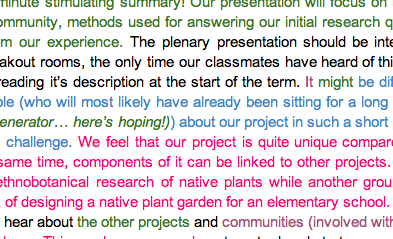The past two weeks, the bulk of our time has been spent on actually gathering information on the first plants we have chosen for our database, and starting to post them. Fortunately, between the books that we have borrowed and online sources, the information we need has, for the most part, not been difficult to find. Many of these sources contain an abundance of ethnobotanical information on the plants, which has been a great relief; given our restriction to published literature, we were worried that there wasn’t going to be enough information of the right kind. The only problems we have encountered involve which headings to use for the breakdown of the plant information. Originally, we had both “nutritional uses” and “medicinal uses”; however, after a group discussion we decided it may be better to group these two together, given that many people consider food as type of medicine. This is especially true within Aboriginal communities. We therefore dubbed it “Food and Medicinal Uses”.
Eduardo then recommended we remove “Aboriginal Uses” from our list of headings because it would overlap so much with “Food and Medicinal Uses”. However, the goal of our research and database from the beginning has been to look specifically at Aboriginal usage, so we are being sure to include which groups used each plant and in what ways, when we discuss these uses. During our research, we have also found that many of the plants have unique stories or legends pertaining to their use or discovery, inspiring an “Interesting Points” heading. Another change we made is switching “Location in BC” to “Location in the Pacific Northwest”. This was because with plants, geographic boundaries are far more relevant than political borders. Once all of this data has been posted on the LFS website, all that remains are the upcoming in-class presentations as well as the final report.
It is interesting to reflect on the challenge of working with titles and knowledge that surround Aboriginal communities. Although previously mentioned in our other blog posts, the constant vigilance to use proper terms and be culturally sensitive is an issue that may not be as pressing when working with an elementary school or a senior’s centre, and is therefore unique to our project. The fact that many Aboriginal cultures traditionally practice oral knowledge transfer, feeling that writing things down inhibits the adaptability and evolution of knowledge, further impresses this issue. This is part of our challenge in bringing traditional knowledge to media of a high-tech society, and without the ability to communicate with aboriginal community members we have had to make some assumptions and take some liberties, something with which we are not entirely comfortable.

Post #8 in the making. (Each colour is a different person!)
This week we will give our plenary presentation to the entire LFS 350 class; this will be a brief overview of our project. Saki and Laura are in charge of presentations, and will therefore be the primary presenters. They are tasked with condensing almost 3 months of work into a 3 minute stimulating summary! Our presentation will focus on briefly introducing our project and community, methods used for answering our initial research question, and what we’ve learned from our experience. The plenary presentation should be interesting because, outside of our breakout rooms, the only time our classmates have heard of this CBEL project was when they were reading it’s description at the start of the term. It might be difficult to engage a class of 200 people (who will most likely have already been sitting for a long time) about our project in such a short period of time, but we are up for the challenge. We feel that our project is quite unique, but at the same time components of it can be linked to other projects. For example, our project involved ethnobotanical research of native plants while another group in our breakout room had the task of designing a native plant garden for an elementary school. Of course we are also very eager to hear about the other projects and their community partners.
Our group hopes to get a head start on our final written report this week, on top of preparing and giving the presentations. With finals just around the corner it would be nice to have it completed early. We are meeting with Eduardo at the end of the week to discuss the layout of our report. We hope to include a section of future recommendations for this project, as we will – sadly – be handing it off once the term is over.
